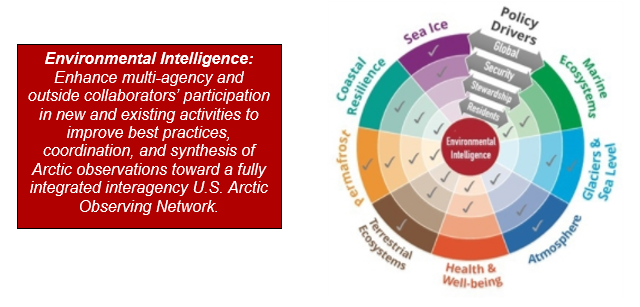US AON cannot perform its wide-ranging mission assignments or develop observation goals single-handedly. It is critical that collaborations with NGOs, the State of Alaska, academia, industry, indigenous groups, and more are engaged in accelerating Arctic research progress. Therefore, US AON works with and through the Interagency Arctic Research Policy Committee’s (IARPC) Collaborations system to build a partnership interface that safeguards diverse cultural, environmental, and economic interests. The Collaborations’ Arctic Observing Systems Team (AOSST) – a sub team of the Environmental Intelligence Team – plays an essential role to familiarize the reach community with US AON and to nurture their engagement to develop environmental intelligence of the Arctic’s rapidly changing land and seascapes. Click here to become an IARPC Collaborations Member and then join the Observing Team!
Background on IARPC’s Current Work
In December 2016, the Executive Office of the President released IARPC’s Arctic Research Plan: FY2017–2021 (the Plan) to advance research in areas of common interest to IARPC Agencies. The IARPC 5-year plan was drafted with contributions from all IARPC agencies and reviewed by the public. The current research plan details nine Research Goals, the first eight of which are:
Research Goals are responsive to two or more of the Plan’s Policy Drivers:
- Enhance the well-being of Arctic Residents. This will inform local, state, and national policies to address and sustain the health, economic growth, and cultural vibrancy of those who call the Arctic home.
- Advance Stewardship of the Arctic Environment. This will result in the necessary knowledge to understand terrestrial and marine ecosystem cycles, anticipate globally-driven changes, and evaluate the potential impact of local actions.
- Strengthen national and regional Security. This will improve shorter term environmental prediction capabilities, as well as longer term projections for security and emergency response agencies to be aptly prepared to operate safely and effectively in the Arctic for years to come.
- Improve understanding of the Arctic as a component of planet Earth (Global). This will inform the Arctic’s role in the global system, including impacts to sea level, carbon and radiation budgets, and extreme weather systems.
Research goals are not prioritized or sequential. Rather, they were intentionally designed around varying levels of development and multi-agency implementation needs, known throughout the report as research objectives. Some objectives have lead and supporting agencies contributing to actions while others have only one agency engaged operationally, but they generate data that are broadly catalytic and influential to potential future interagency engagement. You can learn more about these varying objectives here.
As detailed by the figure below, IARPC’s eight research goals essentially come together, “full circle,” to support and establish the Plan’s ninth goal, Environmental Intelligence. Arctic Observing is a critical component of the Environmental Intelligence research goal. Check marks indicate how the goals support a range of policy drivers from local to global scales. Environmental intelligence crosses all scales.
 The Plan does not attempt to address all Arctic research supported by the Federal Government or recommended by the U.S. Arctic Research Commission due to the Plan’s emphasis on interagency and partnership collaboration. Additionally, the Arctic Executive Steering Committee (AESC) is responsible for coordinating all Federal Government activities in the Arctic, and for the implementation of the National Strategy for the Arctic Region. Some efforts with potentially relevant research components, such as renewable energy, are currently being organized under AESC. As specific research needs are identified, their coordination may be adopted by IARPC.
The Plan does not attempt to address all Arctic research supported by the Federal Government or recommended by the U.S. Arctic Research Commission due to the Plan’s emphasis on interagency and partnership collaboration. Additionally, the Arctic Executive Steering Committee (AESC) is responsible for coordinating all Federal Government activities in the Arctic, and for the implementation of the National Strategy for the Arctic Region. Some efforts with potentially relevant research components, such as renewable energy, are currently being organized under AESC. As specific research needs are identified, their coordination may be adopted by IARPC.


